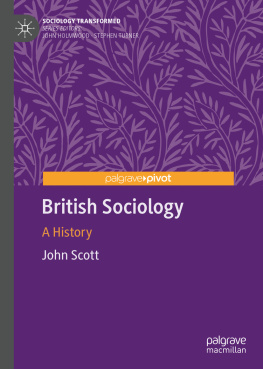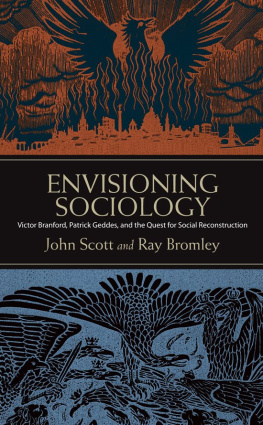THE EMERALD GUIDES TO
SOCIAL THOUGHT
Series Editor: John Scott
The Emerald Guides to Social Thought are a series of student-oriented guides to major thinkers on social issues.
Each book is an authoritative primer that takes the reader through the key ideas of a thinker in order to provide a firm foundation for an independent reading of primary texts, for engagement with the secondary literature, and for reading contemporary extensions and elaborations of those ideas. The Guides demonstrate the mind of the theorist at work by tracing the development of that thought through successive texts or by elucidating the various topics to which they have been applied.
Emerald Guides place the work of a thinker in the context of her or his life and times. Substantive and comprehensive chapters on key issues are followed by full guides to sources of information and translation that provide a clear map of the thinkers intellectual development and to major items of commentary, debate, and application of their ideas.
The Guides are uniquely authoritative and accessible and provide the foundations of a scholarly library that allow the reader to develop his or her own ideas regarding influential thinkers and theorists.
Emerald Publishing Limited
Howard House, Wagon Lane, Bingley BD16 1WA, UK
First edition 2020
Copyright 2020 John Scott. Published under an exclusive licence.
Reprints and permissions service
Contact:
No part of this book may be reproduced, stored in a retrieval system, transmitted in any form or by any means electronic, mechanical, photocopying, recording or otherwise without either the prior written permission of the publisher or a licence permitting restricted copying issued in the UK by The Copyright Licensing Agency and in the USA by The Copyright Clearance Center. No responsibility is accepted for the accuracy of information contained in the text, illustrations or advertisements. The opinions expressed in these chapters are not necessarily those of the Author or the publisher.
British Library Cataloguing in Publication Data
A catalogue record for this book is available from the British Library
ISBN: 978-1- 83982-657-3 (Print)
ISBN: 978-1- 83982-654-2 (Online)
ISBN: 978-1- 83982-656-6 (Epub)
1
TALCOTT PARSONS AND AMERICAN SOCIOLOGY
Once the best-known sociologist in the world, the American sociologist Talcott Parsons is now almost forgotten. His ideas on general theory and structural functionalism once dominated world sociology, being widely regarded as the only viable approach to the subject. Relatively few sociologists today have heard of him or think his ideas worth consideration. Those who remember his name tend to see him as old-fashioned, even misguided. His vision of general theory seems strange, kept alive only by a handful of committed adherents. Even during his lifetime, he was criticised for presenting complex and abstract ideas in unwieldy and incomprehensible texts, and these views are today often taken as grounds for disregarding his work.
I have written this book in the conviction that Parsons has been wrongly criticised and unduly ignored. It is time to reassess his ideas, which properly understood offer a fruitful way of undertaking empirical work and moving towards robust explanations. This explains a recent upsurge of interest in Parsonss sociology, most marked in Germany and the United States. New critical studies of his works have appeared, and the archives have been trawled to find previously unknown draft manuscripts that could be brought to a new audience. These publications make it possible to reconsider the significance and contemporary relevance of Parsonss sociology. My presentation of Parsonss views the first, I believe, to accurately and clearly explain the development of his work without misleading simplification is intended as a contribution to that reassessment and to introducing his theoretical project to a new generation.
Very little is recorded about Parsonss life and personal characteristics. He is known to have been rather short, prematurely bald, a chain smoker, and, in later life, somewhat portly. He was typically dressed in a crumpled tweed suit flecked with cigarette ash. His rich East Coast accent betrayed traces of his origins in the American West. He spoke slowly and hesitantly, with long pauses in which he sought the correct word or followed an incidental thought. Though modest and rather shy in personal situations, his passionate commitment to the vocation of sociology as a systematic, scientific discipline was apparent in discussion and writing. Students and colleagues regarded him as a genial and rather avuncular character whose teaching could inspire students through his quiet, untheatrical passion for the subject. His lectures delivered from brief notes on a yellow legal pad were marked by frequent digressions as he pursued his thoughts enthusiastically and with great determination. Indeed, his students would sometimes wonder where these thoughts would end up. He was, however, unfailingly supportive of his graduate students, treating them as intellectual equals and as contributors to his evolving ideas. His office door was invariably open for students to drop in for discussion on sociological matters. He enjoyed collaborative work and co-authored papers with many former students and colleagues, always giving them full recognition.
Parsons published a great deal perhaps too much aiming to present his work to the widest possible audience. His ideas were published before they were fully formed, as works in progress, and his landmark publications were subject to frequent revision. As a result, he did not always make clear exactly how a paper or book extended or departed from what he had previously published. When writing on specific topics religion, stratification, health, politics, death, ethnicity, education, and many more he felt a need to recap and develop his most general theoretical arguments before coming to the key points, which he then left partially developed. This publication strategy reflected his drive to work things through as systematically as possible and to undertake much of his developing theorisation in public, written form.
It has to be admitted that Parsons did not write especially well. Although the complexity of his ponderous prose has been overstated, it is undoubtedly the case that the highly generalised level at which he wrote and the abstract terminology that he employed, and often invented, alienated many readers. This was exacerbated by his heavy grammar and lengthy sentences. He was, however, convinced that abstraction and complexity were essential if the real complexity of the empirical world was to be understood. The construction of abstract social theory was a means to better understand the social world and so to be able to intervene in practically effective ways.
SOCIOLOGY IN AMERICA
Parsons arrived at sociology indirectly and had no training in the subject, as it was very little developed when he began his undergraduate studies in the early 1920s. University and college teaching of courses in sociology or social science had become established only between 1869 and 1890. Teaching began at the University of Pennsylvania in 1869 and similar courses began in the following years at Yale, Michigan, Indiana, Massachusetts, Colby College, Kansas, Bryn Mawr, Chicago, and Columbia. The long-lasting courses were those taught by William Graham Sumner at Yale, Albion Small at Chicago, and Franklin Giddings at Columbia, these becoming the principal centres of the expanding discipline. At Harvard, the leading New England university, a course on sociology was taught from within a new Department of Social Ethics from 1905, a department label indicating the common emphasis of many early departments on social reform and the training of those entering social work and social administration. Much teaching in the subject was influenced by the religiously inspired social gospel movement and took the form of a self-consciously Christian sociology focussed on the implications of the Sermon on the Mount for practical social improvement.











